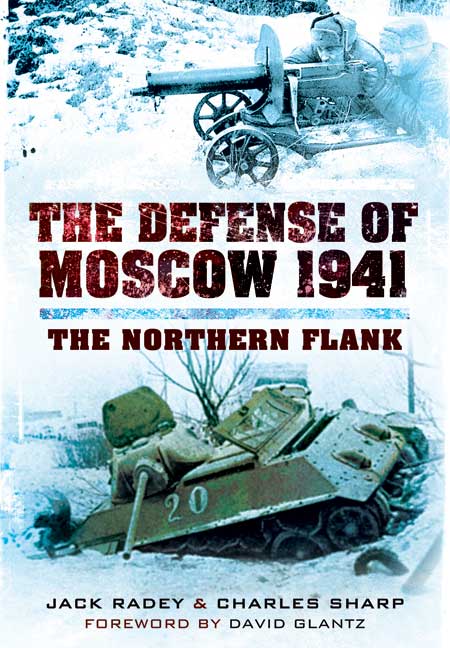The Defense of Moscow 1941 (Hardback)
The Northern Flank
Imprint: Pen & Sword Military
Pages: 280
ISBN: 9781781590706
Published: 5th November 2012
Endorsement
'Clear, concise, and well-written, by skillfully exploiting newly-released and long-neglected archival materials, the authors of this book have provided not only fresh insights as to how and why the battle for Moscow was fought, but also necessary context for understanding why Germany ultimately lost the war. It is a "must read" by historian and layman alike.' - David M. Glantz
(click here for international delivery rates)
Order within the next 6 hours, 25 minutes to get your order processed the next working day!
Need a currency converter? Check XE.com for live rates
| Other formats available - Buy the Hardback and get the eBook for free! | Price |
|---|---|
| The Defense of Moscow 1941 ePub (1.7 MB) Add to Basket | £6.99 |
There was one point when Nazi Germany had its best chance of winning the Second World War on the Eastern Front – in mid-October 1941. Most of the Red Army's forces before Moscow had been smashed or encircled, no reserves were available to defend the capital.
This was Hitler's best opportunity to knock out the Soviet Union. All that stood in his way were a handful of Soviet rifle divisions, tank brigades and hastily assembled militia. According to German accounts, theirspearheads were stopped by the mud, but a close examination of German records undercuts this version of events. Instead it is clear that it was the resistance of this handful of Red Army men and women that halted their drive, along with German planning based on wishful thinking.
This is the dramatic story that Jack Radey and Charles Sharp tell in this compelling study of a pivotal battle in the struggle for supremacy in the East. Using archival records from bothsides, in graphic day-by-day detail, they reconstruct a previously unstudied aspect of the Battle of Moscow. They show how the German plan to encircle seven Soviet armies on the northern flank of their advance would have trapped over a quarter of a million Red Army troops, and cleared their way to the capital. But the Soviet response, poorly coordinated and depending on makeshift forces scraped together from their shattered armies, drove back the German attack. The gripping narrative describes both sides of the wild battle, with open flanks, attacks and counterattacks and extraordinary planning and logistical blunders, and it gives a vivid close-up of the combatants and commanders in action.
Jack Radey and Charles Sharp's book is a remarkable new contribution to our understanding of the initial stages of the war
on the Eastern Front and the breakdown of Hitler's Operation Barbarossa.
Clear, concise, and well-written, by skillfully exploiting newly-released and long-neglected archival materials, the authors of this book have provided not only fresh insights as to how and why the battle for Moscow was fought, but also necessary context for understanding why Germany ultimately lost the war. It is a "must read" by historian and layman alike.
David M. Glantz
Radey and Sharp make good use of German and Soviet archival material, providing superb strategic context for their battle-driven narrative.
War in History
An excellent book and an important addition to our understanding of this decisive battle.
British Commission for Military History
An excellent book and an important addition to our understanding of this decisive battle.
British Commission for Military History
Radey and Sharp have assembled an impressive and very detailed account of the battle between the Wehrmacht and Red Army around Moscow in 1941. They cover the strategic, operational and tactical elements thoroughly and in meticulous detail. Rather than looking at the entire battle, they have picked out a part of the struggle to focus on, one that has rarely been covered in the German and Soviet Official Histories or by Historians since the end of war.
Second World War Operations Blog
In October 1941, when most of the Red Army forces standing between the German Army and Moscow had been smashed or encircled, and no reserves were available to defend the capital, all that stood in Hitler's way were a handful of Soviet rifle divisions, tank brigades and hastily assembled militia. According to German accounts, their advance on Moscow was stopped by the mud, but a close examination of the records shows this was not so. Instead, say the authors of this book, it is clear that it was the resistance of the Red Army coupled with bad planning that halted the Wehrmacht. Using archive sources from both sides, they reveal how the Soviets inflicted a stunning defeat on the German plan to encircle seven Soviet armies on the northern flank of their advance which, if successful, would have cleared the way to Hitler's ultimate prize, the Soviet capital.
Classic Military Vehicle
The authors Jack Radey and Charles Sharpe have brought new archive material from both German and Russian sources to bear. The result is an absorbing day by day account of The Battle of Moscow and the events leading up to it. Really good reading for those interested in the Eastern Front in WW2.
WW2 Connection.com
About Jacky Radey
Jack Radey has researched deeply into the history of the Second World War in general and has made a particular study of the conflict on the Eastern Front. He has written many games, articles and film scripts on subjects as wide ranging as the Korsun Pocket, Borodino ’41, American Civil War battlefields, D-Day, Iwo Jima, and Barbarossa.
About Charles Sharp
Charles Sharp has a long-standing interest in military history. He spent twenty years in the US Army from the Vietnam War. He served in the army through the end of the Cold War and the first Iraq War, retiring in 1992. Since then he has written fifteen books on the Soviet and German armies in the Second World War, published in the Soviet Order of Battle series, and lectured on military history.














